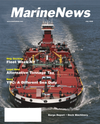
Page 20: of Maritime Reporter Magazine (July 2006)
The Satellite Communication Edition
Read this page in Pdf, Flash or Html5 edition of July 2006 Maritime Reporter Magazine
By Don Sutherland
It was difficult to say which of the two fleets was more formidable. Just outside lay the warships, representing the British
Navy, the U.S. Navy and Coast Guard.
Eleven in all had arrived, soon to be met by the second fleet from Mariner's Harbor, composed of equal numbers. As the first light defined the sky that morning of May 24, eleven tugboats began to stir at McAl- lister's. Coffee was poured as sweeps were completed, and intelligence from the
Naval armada analyzed. Each tug had a soldier, bringing his or her training to the security of it all. Instead of just walking from dock to bitt to caprail to deck like regular people do, some of them jumped.
The fleets would join around the Ver- razano-Narrows Bridge, or at least parts of them would. Seven of the tugs would turn north out of the Kill. McAllister port cap- tain Pat Kinnier confided that action was planned up the North River, just short of the George Washington Bridge.
The Navy warships were nothing if not imposing. U.S.S. Kearsarge, for example, although defined as an Amphibious
Assault Ship, is to anyone's eye an aircraft carrier. She has carrier-like features, such as asymmetrical overhangs and a monu- mental flare, the better to support a flight deck. She was quite a block of steel, to be approached thoughtfully by anyone so ordered.
The other Navy ships were smaller in size, but that's probably all. Today's cruis- ers and destroyers are not to be trifled with. Still, the two groups of tugs — one up the river, the other off Stapleton — had the strategic advantage in the engage- ments to come. Aircraft carriers, and even destroyers, are not at their best making U- turns in the Hudson, and docking them- selves after parades. Turning large ocean ships in confined waters, and easing them into berth, is why tugboats were invented.
Eleven ships to dock in an afternoon makes quite a display in today's New
York, taxing the limit of the physical port.
There are enough piers, because ships can double-up at the Stapleton pier.
McAllister has the Navy shipdocking contract for these parts, and altogether has a lot more than eleven tugs. But such a big 20 • MarineNews • July, 2006
Tug Brian A. McAllister eases the U.S.S. Ramage (DDG 61), an Arleigh Burke class guided missle destroy- er, out of her berth at the end of the week for return to sea. (Photo: Don Sutherland.) 0518 hours on 23 May, the 11-tugboat armada at Mariner's Harbor starts firing-up, in preparation of engaging an equal number of Naval ships at the VNB. (Photo: Don Sutherland.)
Shipdocking Extravaganza 2006
JULY MN2006 3(17-24).qxd 7/6/2006 11:37 AM Page 20

 19
19

 21
21
